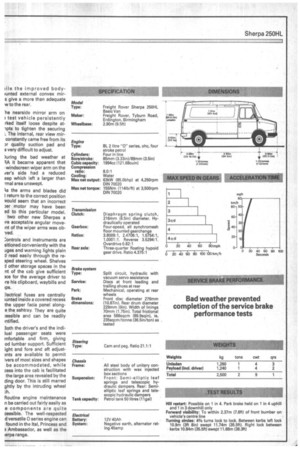Road Test
Page 32

Page 33

If you've noticed an error in this article please click here to report it so we can fix it.
No 28, 1982
In town traffic the gear selection was light and precise with minimal gear lever travel. The clutch pedal, which had considerable resistance initially, felt progressively 6eavier towards the end of the test.
On duel carriageways and main roads the control button mounted in the gear knob made selection of overdrive a smooth operation and, providing it is wisely used, will help to make fuel consumption figures more acceptable. As a fitted extra the overdrive costs an additional £275 on the list price.
At an average speed of 42.48km/hr (26.4mph) our test van returned consumption figures of 12.02 litres/100km (23.5mpg) by making full use of the overdrive where road condi tions permitted it.
The average speed around the light van route was largely affected by the Saturday traffic flow through the towns but its good acceleration and increased pulling power enabled it to keep apace of much of the traffic.
Congestion at the foot of the steep hill out of High Wycombe caused the Sherpa to lose a little time but it eventually cleared the traffic and accelerated towards Marlow.
A five-minute slow crawl past some 20 odd charity runners near Slough who were carrying a decorated Mini car in relays did cause some delay and was not very charitable towards other road users.
During the test considerable resonance occurred through the van body at 64km/hr (40mph) while in third gear, raising the noise level to 86dB(A). At th6 time, it was suspected that the effect was caused by a faulty exhaust system and the unlined van body merely accentuated the resonant effect. To date we have been unable to verify this.
Improved insulation to the bonnet, side panels and bulkhead does reduce the noise level normally so that apart from the sharp resonance mentioned, the noise is held to a quite acceptable level. At 64km/hr (40mph) in fourth gear overdrive the meter registered a very reasonable 6 9dB(A), while at 80km/hr (50mph) the meter showed a reading of 74cIB(A).
Freight Rover offers a choice of nine different options on the type and position of van doors. The van tested had front sliding doors and standard double opening rear doors.
Access to the body's rear has been improved by fitting detachable door restraining straps which, when removed from their mounting pins allow each rear door to open well beyond 150 degrees.
Rear vision is somewhat restricted through the windows of the double doors but the optional full-depth tailgate with its larger window improves this. It is offered as an option at £70 and should appear high on a prospective purchaser's list of extras.
There may well be many future variations of body design on the Sherpa chassis. Whether Freight Rover will produce many of them is a matter for conjecture but Sherpa 255 and 280 models are leaving its Common Lane factory in Birmingham dropside, tipper and Luton bo form.
These versions are built I Freight Rover with body ki supplied by Ingimex of Telfor Shropshire.
The standard van body's fl ribbed floor has few obstri tions, giving it a good sweep-c feature and its reduced rc wheel arch intrusions increa the amount of usable bo space to almost 5.4cu (193cuft).
Mounting the spare wheel side the body will make whi changing quite a speedy opel tion in the event of a flat tyre.
Forward visibility is very goc being more than enhanced the forward sloping body fro lile the improved bodyiunted external convex mirs give a more than adequate w to the rear.
he nearside mirror arm on test vehicle persistently rked itself loose despite atwts to tighten the securing :. The internal, rear view mirconstantly came free from its )ir quality suction pad and s very difficult to adjust.
)uring the bad weather at RA it became apparent that windscreen wiper arm on the ver's side had a reduced eep which left a larger than -mai area unswept.
ks the arms and blades did t return to the correct position vould seem that an incorrect )er motor may have been ed to this particular model. two other new Sherpas a ■ re acceptable angular moveTit of the wiper arms was obved.
:ontrols and instruments are sitioned conveniently with the ages and warning lights plain d read easily through the reaped steering wheel. Shelves
other storage spaces in the nt of the cab give sufficient 3 ce for the average driver to ,re his clipboard, waybills and
ilectrical fuses are centrally lunted inside a covered recess the upper facia panel along
e the ashtray. They are quite ;essible and can be readily ,ntified.
3oth the driver's and the indilual passenger seats were mfortable and firm, giving od lumbar support. Sufficient ight and fore and aft adjustants are available to permit Ivers of most sizes and shapes be accommodated, while cess into the cab is facilitated the large area revealed by the ding door. This is still marred ghtly by the intruding wheel ;h.
Routine engine maintenance n be carried out fairly easily as e components are quite cessible. The well-respected d versatile 0 series engine can found in the Ital, Princess and a Ambassador, as well as the lerpa range.








































